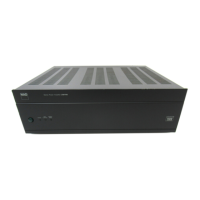
Do you have a question about the NAD Theater 216THX 216THX 216THX and is the answer not in the manual?
| continuous average output power (stereo mode) | 125 W |
|---|---|
| clipping power | 160 W |
| IHF dynamic power 8 ohms (stereo mode) | 170 W |
| IHF dynamic power 4 ohms (stereo mode) | 280 W |
| IHF dynamic power 2 ohms (stereo mode) | 400 W |
| continuous average power output into 8 ohms (bridged mode) | 400 W |
| IHF dynamic power 8 ohms (bridged mode) | 560 W |
| IHF dynamic power 4 ohms (bridged mode) | 800 W |
| rated distortion (THD 20Hz-20kHz) | 0.03% |
|---|---|
| slew rate | >70 V/sec |
| damping factor (ref. 8 ohms, 50Hz) | >200 |
| frequency response | 20Hz-20kHz ±0.2dB |
| signal/noise ratio ref 1 W | 98 dB |
| signal/noise ratio ref rated power | 119 dB |
| input impedance | 60k + 500pF |
|---|---|
| input sensitivity (for rated power into 8 ohms) | 1.1 V |
| voltage gain | x 28.3 (29dBW) |
| dimensions | 435 x 146 x 383 mm |
|---|---|
| net weight | 14.2 kg |
| shipping weight | 16 kg |
Highlights NAD 216 THX's design for performance, reliability, and driving difficult loads via a stiff power supply.
Details the Holmgren toroidal transformer and discrete regulated power supply for clean, noise-free output.
Explains bridged mono mode for increased power and THX certification for dynamic handling.
Covers the output relay protection for silent switching and Soft Clipping for damage prevention.
Details continuous average power, rated distortion, and clipping power for stereo operation.
Lists IHF dynamic headroom and dynamic power ratings at various impedances.
Provides slew rate, damping factor, input impedance, sensitivity, voltage gain, and frequency response.
Specifies signal/noise ratio at different power levels.
Details continuous average power and IHF dynamic power for bridged (monophonic) mode.
Lists the physical dimensions and weight of the amplifier.
